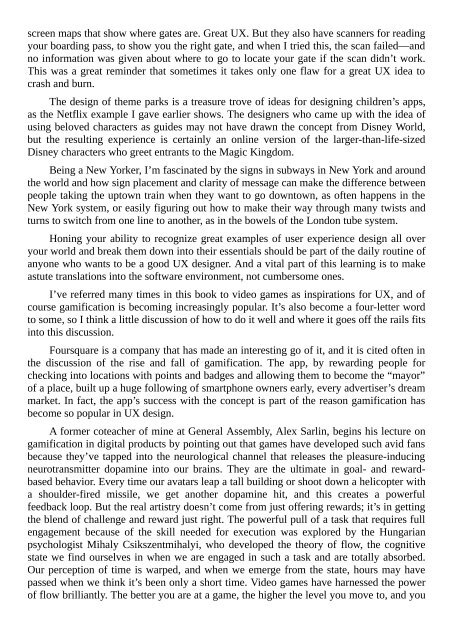Create successful ePaper yourself
Turn your PDF publications into a flip-book with our unique Google optimized e-Paper software.
screen maps that show where gates are. Great UX. But they also have scanners for reading<br />
your boarding pass, to show you the right gate, and when I tried this, the scan failed—and<br />
no information was given about where to go to locate your gate if the scan didn’t work.<br />
This was a great reminder that sometimes it takes only one flaw for a great UX idea to<br />
crash and burn.<br />
The design of theme parks is a treasure trove of ideas for designing children’s apps,<br />
as the Netflix example I gave earlier shows. The designers who came up with the idea of<br />
using beloved characters as guides may not have drawn the concept from Disney World,<br />
but the resulting experience is certainly an online version of the larger-than-life-sized<br />
Disney characters who greet entrants to the Magic Kingdom.<br />
Being a New Yorker, I’m fascinated by the signs in subways in New York and around<br />
the world and how sign placement and clarity of message can make the difference between<br />
people taking the uptown train when they want to go downtown, as often happens in the<br />
New York system, or easily figuring out how to make their way through many twists and<br />
turns to switch from one line to another, as in the bowels of the London tube system.<br />
Honing your ability to recognize great examples of user experience design all over<br />
your world and break them down into their essentials should be part of the daily routine of<br />
anyone who wants to be a good UX designer. And a vital part of this learning is to make<br />
astute translations into the software environment, not cumbersome ones.<br />
I’ve referred many times in this book to video games as inspirations for UX, and of<br />
course gamification is becoming increasingly popular. It’s also become a four-letter word<br />
to some, so I think a little discussion of how to do it well and where it goes off the rails fits<br />
into this discussion.<br />
Foursquare is a company that has made an interesting go of it, and it is cited often in<br />
the discussion of the rise and fall of gamification. The app, by rewarding people for<br />
checking into locations with points and badges and allowing them to become the “mayor”<br />
of a place, built up a huge following of smartphone owners early, every advertiser’s dream<br />
market. In fact, the app’s success with the concept is part of the reason gamification has<br />
become so popular in UX design.<br />
A former coteacher of mine at General Assembly, Alex Sarlin, begins his lecture on<br />
gamification in digital products by pointing out that games have developed such avid fans<br />
because they’ve tapped into the neurological channel that releases the pleasure-inducing<br />
neurotransmitter dopamine into our brains. They are the ultimate in goal- and rewardbased<br />
behavior. Every time our avatars leap a tall building or shoot down a helicopter with<br />
a shoulder-fired missile, we get another dopamine hit, and this creates a powerful<br />
feedback loop. But the real artistry doesn’t come from just offering rewards; it’s in getting<br />
the blend of challenge and reward just right. The powerful pull of a task that requires full<br />
engagement because of the skill needed for execution was explored by the Hungarian<br />
psychologist Mihaly Csikszentmihalyi, who developed the theory of flow, the cognitive<br />
state we find ourselves in when we are engaged in such a task and are totally absorbed.<br />
Our perception of time is warped, and when we emerge from the state, hours may have<br />
passed when we think it’s been only a short time. Video games have harnessed the power<br />
of flow brilliantly. The better you are at a game, the higher the level you move to, and you


